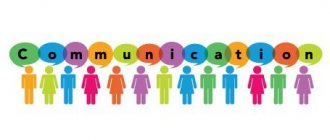Introduction
The main form of information transfer for a person is communication.
Communication is one of the basic psychological categories. A person becomes a person as a result of interaction and communication with other people. Communication is a complex, multifaceted process of establishing and developing contacts between people, generated by the need for joint activities and including the exchange of information, the development of a unified strategy for interaction, perception and understanding of the communication partner.
In its most general form, communication acts as a form of life activity. Its social meaning lies in the fact that it acts as a means of transmitting forms of culture and social experience. The specificity of communication is determined by the fact that in its process the subjective world of one person is revealed to another. In communication, a person self-determines and presents himself, revealing his individual characteristics. By the form of influence one can judge a person’s communication skills and character traits, and by the specifics of the organization of a speech message one can judge general culture and literacy. Truly human communication is impossible without the participation of consciousness and reason. Along with the content of communication, its means are distinguished, which are language and speech. But not only the verbal expression of thoughts can convey the necessary information. Much more informative than verbal means is non-verbal communication - gestures and facial expressions.
Thus, communication is a complex multifaceted process represented by three sides: communicative, interactive and perceptual. Communication was the subject of our study.
The purpose of our work was to study the problem of the relationship between verbal and nonverbal means of communication in activity.
The following tasks served to achieve the goal:
1. Consider the concept of “communication”.
2. Describe the main types of communication: verbal and non-verbal.
3. Study the issue of the relationship between verbal and non-verbal means of transmitting information.
What is communication
Communication is a process of interaction between people, a way of establishing contact for the exchange of emotions, information, ideas, thoughts between interlocutors. With the help of communication, people show their sympathy or dislike and express their attitude towards another person. Everyone’s communication abilities are different; they depend on the individual’s intellectual development and skills of interacting with society—communication skills.
Communication using articulate speech is one of the main distinguishing features of humans from animals. Animals also know how to communicate, but their interaction occurs through a system of sounds, vibrations, and gestures.
This is interesting! Some species of exotic fish communicate with each other by changing their color, ultrasound, and making sounds similar to rumbling, birdsong, and drumming.
A person develops communication skills from early childhood. In the first years of life, it becomes a way to tell parents about your wants and needs. Over time, thanks to communication, a person can not only convey his feelings, but also understand those around him, learn about their experiences, desires, and interests.
Chapter 1. Communication as a means of transmitting information
The concept of communication is closely related to the concept of communications. The act of communication is analyzed and evaluated according to the following components: addressee - the subject of communication, addressee - to whom the message is sent, message - the transmitted content, code - means of transmitting the message, communication channel, and result - what is achieved as a result of communication.
Communication is a complex process of interaction between people, consisting of the exchange of information, as well as the perception and understanding of each other by partners. The subjects of communication are living beings. The person transmitting information is called a communicator, and the person receiving it is called a recipient.
A number of aspects can be distinguished in communication: content, purpose and means.
The content of communication is information that is transmitted from one living being to another in inter-individual contacts.
The purpose of communication - the same principle applies here as was already mentioned in the paragraph on the content of communication. In animals, the goals of communication usually do not go beyond the biological needs that are relevant to them. For a person, these goals can be very, very diverse and represent a means of satisfying social, cultural, cognitive, aesthetic and many other needs.
Means of communication are ways of encoding, transmitting and processing information that is transmitted in the process of communication from one being to another. Encoding information is a way of transmitting it. Information between people can be transmitted using the senses, speech and other sign systems, writing, technical means of recording and storing information.
Communication performs a number of functions in human life:
1. Social functions of communication: organization of joint activities; behavior and activity management; control.
2. Psychological functions of communication: the function of ensuring the psychological comfort of the individual; satisfying the need for communication; self-affirmation function.
Communication can occur at various levels:
1. The manipulative level is that one of the interlocutors, through a certain social role, tries to evoke sympathy and pity from the partner.
2. Primitive level, when one of the partners suppresses the other (one is a constant communicator, and the other is a constant recipient). 3. The highest level is the social level when, regardless of social role and status, partners treat each other as equal individuals. Depending on the content, goals and means, communication can be divided into several types:
In the most general classifications, three aspects of communication are distinguished:
1) communicative; 2) interactive; 3) perceptual.
According to the criterion of the purpose of communication, eight functions of communication are distinguished:
1) contact, the purpose of which is to establish contact as a state of mutual readiness to receive and transmit messages and to maintain relationships in the form of constant mutual orientation;
2) informational, the purpose of which is the exchange of messages (reception and transmission of information in response to a request), as well as the exchange of opinions, plans, decisions, etc.;
3) incentive, the purpose of which is to stimulate the partner’s activity in order to direct him to perform certain actions;
4) coordination, the purpose of which is mutual orientation and coordination of actions when organizing joint activities;
5) the function of understanding, the purpose of which is not only adequate perception and understanding of the meaning of the message, but also mutual understanding of intentions, attitudes, experiences, states, etc.;
6) amotivational, the purpose of which is to arouse the necessary emotional experiences in the partner (exchange of emotions), as well as with his help to change one’s experiences and states;
7) the function of establishing relationships, the purpose of which is to realize and fix one’s place in the system of role, status, business, interpersonal and other connections of the community in which the individual operates;
 the function of exerting influence, the purpose of which is to change the state, behavior, personal and semantic formations of the partner, including his intentions, attitudes, opinions, decisions, ideas, needs, actions, activities, etc.
the function of exerting influence, the purpose of which is to change the state, behavior, personal and semantic formations of the partner, including his intentions, attitudes, opinions, decisions, ideas, needs, actions, activities, etc.
The communicative side of communication is associated with identifying the specifics of the information process between people as active subjects: taking into account the relationships between partners, their attitudes, goals and intentions. All this leads not just to the movement of information, but to the clarification and enrichment of knowledge, information and opinions that people exchange. The means of the communicative process are various sign systems:
1) first of all - speech;
2) optical-kinetic system of signs - gestures, facial expressions, pantomime;
3) paralinguistic and extralinguistic systems - intonation, non-speech inclusions in speech (for example, pauses);
4) a system for organizing space and time of communication;
5) finally, the “eye contact” system.
The interactive side of communication is the construction of a general interaction strategy. There are a number of types of interaction between people, primarily cooperation and competition.
The perceptual side of communication includes the process of forming an image of another person, which is achieved by “reading” the partner’s physical characteristics of his psychological properties and behavioral characteristics. The main mechanisms of knowing another person are identification (assimilation) and reflection.
Thus, communication is a multifaceted process of developing contacts between people, generated by the needs of joint activities. Communication is also a specific form of human interaction with other people as members of society, which has its own structure, features, and functions.
Psychology of communication
2.1. Information or communication
Communication
(Latin
communicatio
from
communico
- I make it common, I connect, I communicate) communication, the transfer of information from person to person, a specific form of interaction between people in the processes of their cognitive and labor activity. Speaking about the communicative or informational side of communication, we, first of all, mean the exchange between people of various knowledge, ideas, ideas, feelings, attitudes, etc.
The need for new experiences is one of the most important human needs. Information hunger, spiritual thirst, just like hunger itself, and we cannot quench real thirst, except with the help of other people. Look who you are interested in spending time with? By choosing another person to communicate, we unconsciously seek to satisfy our powerful need, the need for information. Therefore, first of all, those who can be its source, who will tell us something important for us, are selected.
This was confirmed during the psychological experiments of Yakov Kolominsky. When schoolchildren of different ages chose partners for various activities, he asked them the question: “Why do you want to play (sit at the same desk, etc.) with so and so?” And among the answers very often there were statements: “He tells a good story,” “He knows a lot of all kinds of stories,” “She is aware of everything,” “It’s interesting to be with him.” In all these cases, the actual conscious motive for choice was the information content of the partner, which was expressed in speech.
The study found that the most popular people and those who occupy a more favorable position in the group tend to speak out more often and have greater awareness. An interesting person is, indeed, first of all, a source of information, and not just any information, but information that is new and significant for this person. This means that it is necessary to introduce a distinction between two, at first glance, similar concepts - a person’s awareness and his informativeness.
Awareness
is the stock of knowledge available to a person. Roughly speaking, someone who has read two hundred books, other things being equal, is 2 times more informed than someone who has read a hundred. Information content is understood completely differently.
Information content
is the expected ability of a person to serve as a source of information for another person. One can imagine the intended participants in communication as communicating vessels. You probably remember from your physics course that for a flow to occur, a difference in the levels of “information fluid” is necessary. But if in the case of real communicating vessels, the greater the difference in levels, the stronger the flow, then in the information channel Niagara is impossible: the gateways of misunderstanding will block the communication channel. If there is too much information or it is very complex, it ceases to be perceived.
An example on this topic can be found in an old psychology textbook. A father-physicist and his two sons, a ninth-grader and a sixth-grader, came to a lecture by a physics professor. After the lecture, an exchange of impressions took place. “The lecture did not contain anything new,” said the annoyed father. “Yes, yes, I was completely bored, I wanted to sleep all the time,” supported the youngest son. “It’s not true,” the ninth-grader objected, “it was very interesting!” Isn't this a psychological law about communicating vessels with information - the equivalent of the famous physical problems with pipes?
It is especially important to emphasize in this case the importance of the other, the one who listens. His role in the emergence of information content is no less important than the role of the one who speaks, although, of course, outwardly it seems more passive.
The thirst for knowledge, like the thirst for communication, implies joint bilateral activity. The one who gives out information needs a person who is able to perceive it no less than the listener in the speaker. A person giving a lecture in an empty hall will be funny. Even so-called monologues, which are often found in fiction, in reality they are almost always an expression for others and a statement intended for the listener, even if implied.
It is not for nothing that schoolchildren, when drawing the ideal of an interesting person, emphasized many times that this is someone who can understand you. “Happiness is when you are understood,” writes one of the characters in the film “We’ll Live Until Monday” in the essay; “Make a wonderful miracle, make sure they understand me,” sings N. Matveeva; “It’s not often that someone understands me, well, at least once. From my wounded lips I lifted a horn scratched by a bullet,” dreams A. Voznesensky.
And all because in the informativeness of a person, the desire to receive information is fused with the internal need to share it, give it, and become a source of it for another. Hence, the interestingness of a person, writes Y. Kolominsky, is almost always a state of mutual interest, or at least the hope of such. It is not for nothing that when in experiments they ask subjects: “Who do you think will choose you?”, most often they name those whom they chose themselves.
However, information exchange is too simple, a narrow understanding of the communication process. In this case, the process of communication and exchange of information are one and the same. But this approach to human communication is very simplistic. What is not taken into account here is that in communication conditions information is not simply transmitted and received. Communicating people are not at all like radio transmitters and radio receivers with a recording device. In the course of communication, information undergoes various changes: it is formed, clarified, and developed. Remember the game "Broken Phone". Participants whisper one, very simple word to each other. However, even it rarely reaches the end of the chain in its original, undistorted form.
Communication cannot be viewed as simply sending or receiving information because each interlocutor strives to “win” attention, be active, and influence the other. It would be correct to speak not about the “movement” - “transfer” of information, but about the exchange of it.
Information, as such, can be of two types: motivating and stating. Incentive information appears in the form of an order, advice or request. It is designed to evoke and stimulate some kind of action. Incentive information is divided into activation, when the listener begins to act in a given direction; interdiction, which prohibits undesirable activities, and destabilization, which means a mismatch or violation of certain forms of behavior. Sometimes the same information causes different manifestations. And if the teacher reports that there are 5 minutes left before the end of the test, then for those children who study well this is a signal to finish writing faster (activation), for those who were talking, waiting for the opportunity to copy, to stop the conversation (interdiction), and for those who , who knew nothing at all, understands that he won’t be able to do anything anyway - puts the pen aside (destabilization).
Ascertaining information appears in the form of a message and does not imply a direct change in behavior. We listen to news on the radio or television every day, but this does not mean that anything changes in our behavior.
In order for the exchange of information to take place, the interlocutors must at least understand each other and speak the same language. The legend about the construction of the Tower of Babel said that people became proud and decided to challenge God - to build a tower up to the sky. God was afraid that people could succeed in this, for “...they all have one language...and whatever they decide to do will be possible for them.” In an effort to prevent this, God came down from heaven and confused the languages of people, “so that they could not understand each other’s speech.”
Language
- a system of signs that serves as a means of human communication, thinking and expression of feelings.
Speech
- a form of communication mediated by language that has developed historically in the process of material transformative activity of people. The legend states that since then people have been speaking different languages. In this way, in ancient times they explained the multilingualism of peoples, which to this day makes communication between them difficult.
It often happens that, even knowing the meaning of the same words, people do not always understand them in the same way.
Meaning
- a generalized form of reflection by the subject of socio-historical experience acquired in the process of joint activity and communication and existing in the form of concepts, objectified in patterns of action, social roles, norms and values. Therefore, having heard the word “root,” a botanist will imagine the root of a plant, a mathematician will imagine the square root of a number, a doctor will imagine the root of a tooth, a Russian language teacher will imagine the root of a word. As a result, the communication process becomes much more complicated.
2.1. Verbal communications
For a person to be understood, it is not enough for him to have good diction. He must be clear about what he is going to say. In addition, the speaker must choose such words so that the thought is correctly understood. If a person has to speak in front of a large audience, he formulates theses for himself or otherwise prepares for the report. But in everyday life, oral communication requires spontaneity, and this can cause anxiety, uncertainty and even fear in a person. That is why developed verbal abilities at the present time, in the age of a market economy, are of decisive importance in the success of socially oriented activities.
Verbal communications is understood as the process of transmitting and receiving information through a sign system - human speech, natural sound language, a system of phonetic signs, which includes two principles: lexical and syntactic.
Speech is the most universal means of communication, since when transmitting information through speech, the meaning of the message is least lost. True, this should be accompanied by a high degree of common understanding of the situation by all participants in the communication process.
With the help of speech, information is encoded and decoded: the communicator encodes while speaking, and the recipient decodes this information while listening. Thus, the communication process is built according to the scheme: “communicator – message – recipient”. The accuracy of the listener’s understanding of the meaning of the statement can become obvious to the communicator only when a change in “communicative roles” occurs, i.e. when the recipient turns into a communicator and with his statement makes it known how he revealed the meaning of the received information. This form of communicative interaction is called dialogue.
In general, speech performs two main functions - significative and communicative.
Thanks to the significative function, it becomes possible for a person (as opposed to an animal) to voluntarily evoke images of objects and perceive the semantic content of speech. Thanks to the communicative function, speech becomes a means of communication, a means of transmitting information.
The following types of verbal communication are distinguished: external and internal speech. External speech is divided into oral and written. Oral speech, in turn, is divided into dialogic and monological. When preparing for oral speech and especially for written speech, the individual “pronounces” the speech to himself. This is inner speech. In written speech, the conditions of communication are mediated by text. Written speech can be immediate (for example, exchanging notes at a meeting, at a lecture) or delayed (exchanging letters). Dactyl speech is a unique form of verbal communication. This is a manual alphabet that serves to replace oral speech when deaf and blind people communicate with each other and with persons familiar with dactylology. Dactyl marks replace letters (similar to printed letters).
An important component of the communication process is the ability to listen, which, first of all, influences the correct perception of the information received.
Naturally, verbal communication is dominant in any area of human activity. Professional speaking skills are becoming an important component of success in many professions.
Types and levels of communication
If we characterize the forms more precisely, we will get such a concept as “ types of communication .” This classification describes the relationship, giving it bright and specific features:
- Primitive - when people look at the interlocutor as an object on whom they label “can be used / not needed.” And in accordance with this, they try to improve relationships, or they leave the dialogue, avoid it.
- Formal-role – when the method of communication, its essence and content is established. The social function of a person in a particular group plays an important role.
- “ Contact of masks ” - the usual hypocrisy (what is this?), insincerity or simply politeness is used without the desire to understand the interlocutor. The connection is formed exclusively on a superficial and formal level.
- Business - during a conversation, they focus on the matter, the issue. But at the same time, they can pay attention to some of the partner’s traits and take into account their character. Everything in order to achieve your goal.
- Manipulative - different methods are used to get benefits from the interlocutor (ostentatious indifference, false haste, assertion of authority).
- Secular - people do not express their real point of view, but simply talk about nothing. As a rule, the purpose of such chatter is to meet profitable people and to show off oneself to others.
- Spiritual – when the interlocutors know each other’s personalities well. When communicating, they take into account interests, preferences, and can suggest reactions to words.
Types provide a more diverse description of communication. Levels describe the attitude of people within the framework of communication. Researcher V.N. Sagatovsky highlights:
- The level of manipulation is the attitude and treatment of people as an object to achieve a goal.
- The level of “ reflexive play ” - a person in a dialogue understands that both have plans for each other. But they are trying to show that they just have normal communication without pitfalls.
- Level of legal communication - the behavior of the interlocutors is coordinated, taking into account specific rules and norms.
- Level of moral communication - the relationship arises on the basis of the unity of internal qualities.
2.2. Nonverbal Communication
Nonverbal communication is a system of nonverbal symbols, signs, codes used to convey a message with a high degree of accuracy, which is to one degree or another alienated and independent of the psychological and socio-psychological qualities of the individual. Ph.D. has a fairly clear range of meanings and can be described as a linguistic sign system. Conventional, intentional, arbitrary gestures, body movements, postures, facial expressions are encoded and decoded, act as signs that have a limited range of meanings, and perform the functions of a message.
Nonverbal communication, based on the means of presenting information, can be divided into kinesthetics, para- and extralinguistics, proxemics and “eye contact” (visual communication).
Kinesthetics is a type of nonverbal communication based on the perception of general motor skills of various parts of the human body. If we mainly mean hands, then this is gesticulation (sign language). If we mean facial muscles, then this is facial expressions. If there is a person’s posture, then this is pantomime (body language).
General motor skills of various parts of the body (gestures, facial expressions, pantomime) reflect a person’s emotional reactions. However, it should be borne in mind that the use of the same kinesthetic techniques (gestures, postures, facial expressions, etc.) in different folk cultures may have different interpretations. For example, the V-shaped sign with the fingers in many countries means the number 2. In most European countries, this sign means “Victory!” – it doesn’t matter whether the palm is turned towards yourself or towards the viewer. There are many such examples of different interpretations of certain gestures in different national cultures.
Paralinguistics is a vocalization system (voice timbre, range, tonality, etc.).
Extralinguistics is a system that determines the rate of speech and includes “additions” to verbal information (rate of speech, pauses, coughing, crying, laughter, etc.).
Proxemics is the field of spatial and temporal organization of communication. The founder of proxemics, E. Hall, proposed a method for assessing the intimacy of communication based on studying the organization of its space. Thus, the dimensions of a person’s personal spatial territory (meaning the norms of a person’s closeness to a communication partner, characteristic of American culture) are: intimate zone – 15–46 cm; personal zone – 46-120 cm; social zone – 1.2–3.6 m; public area – more than 3.6 m.
Chapter 3. Interaction of verbal and non-verbal means of transmitting information
The purposeful study of the interaction of verbal and nonverbal means of communication dates back to the heyday of oratory in ancient Rome (II-I centuries BC). Cicero believed that all the feelings of the speaker should be “expressed, or rather, burned on his own face.” In the 1st century BC. oratory theorist Quintilian developed a theory of gesture, facial expressions, posture, as well as rules for the movement of shoulders, arms and head, breathing and voice of the speaker.
Both verbal and non-verbal means are signs by their nature; they perform the basic functions of communication - informational, pragmatic and expressive. But if verbal signs are predominantly conventional symbols, that is, unmotivated and indicate the realities of reality, then non-verbal signs, in particular, gestures and facial expressions, for the most part are indexical signs, unmotivated and signal feelings, emotions, evaluative attitudes, for example, frowning eyebrows signal dissatisfaction, disagreement, doubt, etc.
There are also much more complex phonation means, expressed in the personal characteristics and emotional states of the speaker - timbre, tempo, sonority or dullness, strength, pitch, monotony of the voice and others. Phonation means are most closely related to verbal means - in fact, they “voice” words in a speech context, give utterances communicative completeness and expressiveness, and this is the difficulty of identifying their own functions. These include:
- social-informational - with the help of accents and other pronunciation features, signs of the social status of communicants, demographic characteristics and evaluative orientation are updated;
- evaluative - expressed using logical stress and tone (in this case, the verbal expression of evaluation may not correspond to the tone intentionally or unintentionally);
- emotive - expressed using volume, height of voice, pause,
sigh, tempo, and also with the help of vocalizers - non-verbalized sounds
like “mm-mm”, “uh”, “um”;
- regulating - is expressed with the help of pauses, signaling the beginning, continuation or completion of a statement, the expectation of a response.
It is difficult to clearly determine which functions are assigned to a given phonation device, because in most cases their components are used simultaneously, for example, tone and characteristic properties of the voice. But the natural properties of the voice have a subjective interpretation, as well as tempo. The most “loaded” in functional terms is the tone, which is capable of conveying various signs of evaluative information. It is noted that the emotions of fear and anger are better recognized by tone, but feelings such as love and sadness, pride and satisfaction are poorly distinguished. Within the framework of an utterance, verbal and phonation means function synchronously, and this determines their close interaction in the interpretation of semantic and evaluative information.
Kinesics, including facial expressions, are used in three basic functions, within which various particular functions are actualized. Information functions include: messages about someone or something (the thumb and middle fingers raised up form the initial letter of the English word Victory “Victory”, the palm should be turned towards the audience), messages about the properties of someone or something or (widely spaced palms showing large size, thumbs up indicating high quality), messages about actions (roll up sleeves before starting an action, work), indicating the location of someone or something (indicate as appropriate finger direction, head movement, gaze).
The following particular functions have a pragmatic orientation:
1. Establishing contact (using gaze); establishing feedback;
2. Self-presentation (stand with your arms crossed over your chest as a sign of your independence);
3. Social orientation;
4. Incentive (to silence with a glance, to call for silence with the clap of palms);
5. Regulatory (look indicating the beginning and end of a statement, hand gestures) Expressive functions include:
6. Emphatic (raising the index finger emphasizes the importance of information, waving the finger from side to side emphasizes categorical disagreement or denial of something);
7. Emotive (using facial expressions, gaze, various gestures and postures, various feelings and emotions are demonstrated);
8. Adaptive (gestures and body movements, often unconscious, expressing embarrassment, nervousness, doubt, etc.).
Unlike phonation devices, kinemes can function independently. Autonomous functioning of nonverbal means takes place in three cases: when it is not possible to use verbal means (the interlocutor is at a far distance, noise interference, communication in underwater conditions, etc.), when for some reason it is impossible to use speech to transmit information and in conditions of adaptation to a tense situation (unconscious use of gestures and some components of gaze - pupil dilation, blink rate, etc.
Gestures, in addition to (self) adapters and iconic ones, often function in close interaction with verbal means. In related functioning, gestures can be used: a) synchronously, simultaneously with verbal means, b) preceding verbal means and c) following them.
Thus, the simultaneous use of verbal and nonverbal means is determined by the desire to specify information, make it more expressive and meaningful in order to influence the interlocutor. Despite the fact that in related use non-verbal means occupy the “secondary plane” of communication, they perform the function of influence with greater efficiency.
Communication functions
Communication performs the following important functions in human society:
- Information exchange. People get to know themselves and the world around them faster and better thanks to the opportunity to share their acquired knowledge and accumulated experience with each other.
- Inspiration to activity. With the help of communication, people encourage others to take certain actions, inspire them to fulfill their duties and help society.
- Conveying emotions. Through various means of communication, people exchange their experiences, feelings, and impressions with each other.
In addition, communication performs several more important functions: establishing contacts between people, achieving mutual understanding, forming and developing personality.
The establishment of positive or negative feedback between interlocutors depends on how successfully the communication process occurs. Communication often leads to misunderstanding and the emergence of conflicts on this basis. You can get out of the conflict by mutual concessions (compromise) or by avoiding further contact or conversation with the instigator of the conflict.
To ensure that as few conflicts as possible arise in society and that interlocutors respect and understand each other, etiquette was created as the basis for interpersonal communication.
Bibliography
- Akishina A.A., Kano H.g. Akishina T.E. Gestures and facial expressions in Russian speech. Linguistic and regional dictionary. M., 1991. – 144 p.
- Bodalev A.A. Personality in communication. – M., 1983. – 271 p.
- Gorelov I.N. Nonverbal components of communication. M, 1980. – 238 p.
- Grigorieva T.G., Linskaya L.V., Usoltseva T.P. Fundamentals of constructive communication: Method. manual for teachers. — Novosibirsk; M.: Novosibirsk Publishing House. university; Perfection, 1997. - 171 p.
- Konetskaya V.P. Sociology of communication. - M., 2006. - 304 p.
- Labunskaya V. A. Introduction to the psychology of nonverbal behavior. Rostov-on-Don, 2004 - 415 p.
- Leontyev A.A. Psychology of communication. 3rd ed. - M.: Smysl, 1999. - p. 252.
- Lisina M.I. Problems of ontogenesis of communication. - M.: Pedagogy, 1986. - 144 p.
- General psychology: Textbook for teachers. Institute / Ed. A. V. Petrovsky, M. Progress 1980. - 422 p.
- Pease A. Body language (how to read thoughts by gestures). - M.: EKSMO-Press, 2000. - 139 p.
- G.G. Pocheptsov. Theory of communication - M.: "Refl-book", K.: "Vakler" - 2001. - 656 p.
- Comparative analysis of attack or intrusion detection systems
- Comparative analysis of attack or intrusion detection systems
- Features of the vector editor CorelDraw
- General characteristics of scripting languages. Python language
- Legal acts of management: concept, functions and forms
- Application of OLAP technologies in business
- Fatigue and recovery
- Modern systems of physical exercises
- Methodological principles of physical education (“Physiology of physical education and sports”)
- Economic efficiency and limits of government intervention in the market process
- Gymnastics and its effect on health
- Basics of Nonverbal Communication










